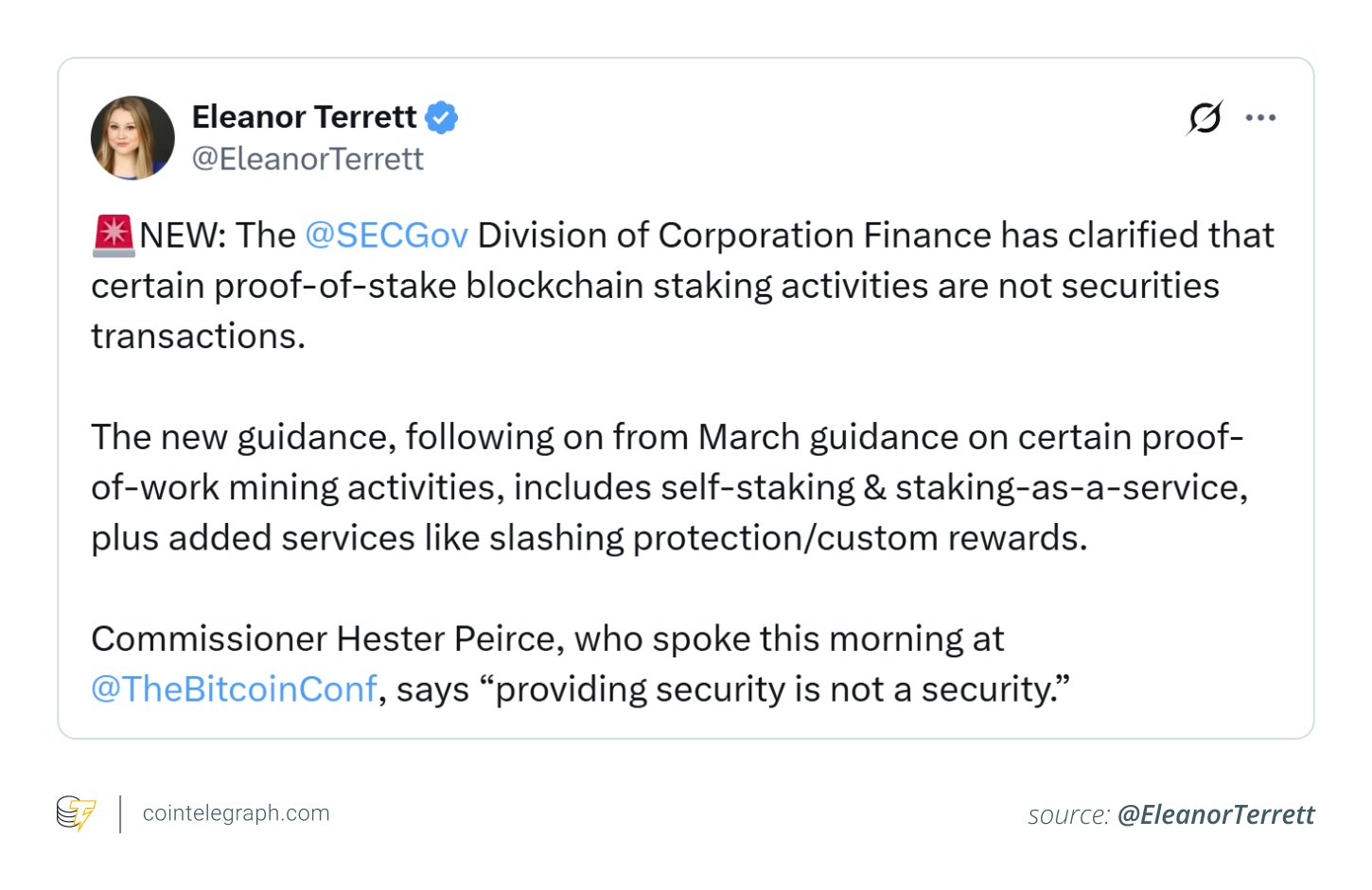Key takeaways
-
SEC has clarified that solo efforts, delegated stacking and depot when they are bound directly to a network consensus process do not qualify as a securities.
-
Post 29 May Guideline, Rewards earned by Network Validation, are seen as compensation for services, not profits from the endeavors of others and removing them from the Howy test classification.
-
Validators, node operators and retail or institutional stakes can now participate without fear of regulatory uncertainty and encourage a wider adoption of POS networks.
-
Dividends of agriculture, Roi-guaranteed Defi-bundles and stack-undergoing lending schemes remain outside legal boundaries and can be treated as a securities.
On May 29, 2025, the US Securities and Exchange Commission issued new guidance on Crypto Stacking to bring legislative clarity. Before the guideline was issued, investors and service providers were uncertain whether regulators would consider poor wages as securities or not, which risked legal problems.
SEC’s latest step clearly outlines what types of efforts are allowed and which are not. The guidance provides clear legislative support to node operators, validators and individual stakes who recognize protocol stays as a core network function rather than a speculative investment.
This article explains how regulators will treat crypto stacks under the new rules, what activities are still not allowed, who will benefit and what practice to avoid.
Whether you are a solo -validator or using a stacking service, understanding these updates is the key to remaining compatible in the United States.
SEC’s latest guidance on efforts
By 2025, SEC’s Division of Corporation Finance released groundbreaking guidance indicating the scenarios when the protocol stabbed on Proof-of-Stake (POS) network is not considered a securities.
-
This guide applies to solo efforts, delegates to third-party validators and custodians as long as these methods are directly linked to the network’s consensus process.
-
SEC clarified that these stack activities do not meet the criteria for an “investment contract” under the Howey test.
-
The regulator also separates genuine protocol rods from schemes that promise profits from the efforts of others, such as lending or speculative platforms.
-
Under the guidance, poor salaries earned through direct participation in networking activities, such as validation of transactions or securing blockchain, will not be considered a return on investment.

What content activities are allowed according to the new SEC rules?
SEC’s Division of Corporation Finance has clarified that specific stack activities on POS networks when performed as part of a network consensus process does not constitute a securities. These protocol compensation activities are considered administrative, not investment contracts.
Here’s what the guidelines explicitly allow:
-
Solo Staking: The new SEC guidelines allow individuals to insert that use their crypto assets using their resources and infrastructure. As long as they retain ownership and control of their assets and participate directly in network validation, their efforts are not treated as a securities vendor.
-
Delegated effort (non-parenting authority): SEC has enabled users to delegate their validation rights to third-party nodes while keeping control of their crypto assets and private keys. It remains compatible as this does not involve transferring ownership or expecting profits from the managerial efforts of others. Whether a node operator stakes his own crypto assets do not change the Howy analysis of protocol features.
-
Detention mood: Managers such as Crypto Exchanges can stick on behalf of users if assets are clearly kept to the owner’s benefit, not used for other purposes, and the process is transparent to the owner before the activity.
-
Continuous Validator Services: The guideline allows you to operate validator nodes and earn rewards directly from the network. These actions are considered the delivery of technical services rather than investing in a third -party business.
Did you know? Solo insert requires running your own knot, often with high minimum requirements, such as 32 ether (ETH) for Ethereum. Pooring pools give users combined smaller amounts and democratization of access.
SEC -Guideline for Auxiliary Services in Crypto -Intoor
Service providers can offer “help services” to crypto assets owners. These services must be administrative or ministerial and do not involve entrepreneurial or management efforts:
-
Slashing cover: Service providers can compensate owners for loss due to cuts, similar to protection in traditional business transactions that cover the node operators’ errors.
-
Early Ubinding: Protocols can return assets to owners before the protocol’s unbound period ends and shorten the waiting time for owners.
-
Flexible Reward Plans: Projects may provide staff salaries on a schedule or frequency that differs from the protocol without fixing or guaranteeing amounts beyond what the protocol provides.
-
Asset Aggregation: Protocols can combine owner’s assets to accommodate minimum interior design, an administrative step in the validation process that supports efforts without being entrepreneurship.
How the new SEC guidelines will benefit stakeholders in a POS —Cosystem
SEC’s guidance on protocol mood supports different stakeholders in the POS ecosystem.
The main benefits include the following:
-
Validators and Home Operators: They can now enter into assets and earn rewards without registering under securities law. This clarity reduces legal risks to individual stakes and professional operators on networks such as Ethereum, XDC and Cosmos.
-
POS -Network developers and protocol teams: The Guide confirms that protocol taking is not considered an investment contract that validates POS network design. This allows developers to grow their projects without changing token economy or compliance structures.
-
Detention providers: Crypto exchanges and platforms offering depot stitches can work legally by clearly passing on terms and storing assets in separate, non-specifying accounts.
-
Retail Investors and Institutional Participants: They can engage in solo or delegated efforts with greater security. This clarity encourages observance-focused institutions to participate in the POS ecosystem.
These rules are likely to promote wider participation in efforts, strengthen POS blockchain security and decentralization by increasing the number and diversity of validators.
Did you know? The concept of effort dates back to 2012 with pepercoin, the first POS blockchain. Unlike miningIt gives users “deployed” coins to validate transactions that inspire modern networks such as Ethereum -Consensus layer and Cardano To prioritize energy efficiency and wider participation.
Stack vs. Securities: Where SEC draws the line
While SEC’s latest guidance facilitates protocol -based efforts tied to network consensus, it draws a clear line between legitimate efforts and activities similar to investment contracts. The following practice still remains outside the guideline of the guideline:
-
Yield agricultural or stack forms not tied to consensus: Serving returns from depositing tokens in pools that do not contribute to blockchain validation or network security is still falling under securities law.
-
Bundled, opaque defi -insert products that promised ROI: Platforms that offer complex, total products with unclear reward sources or surplus guarantees remain at risk of regulatory control.
-
Centralized platforms explaining lending as efforts: Services that provide user funds or generate returns through third -party investments while noticing the “stake” do not qualify under the new guidance and can be treated as unregistered securities.
This statement relates to protocol taking generally rather than all its variations. It does not address all kinds of efforts, such as inserts-as-a-service, liquid staking, resting or liquid residue. Node operators are generally free to share rewards or impose fees for their services in ways that differ from the protocol.

Best practice for legal crypto in 2025
Since SEC formally recognizes protocols such as non -security activity, participants and service providers should adopt thought -provoking compliance measures to remain within the safe zone. This practice ensures clarity, protects user rights and reduces legislative risk.
Here is the best practice for legal crypto stack in 2025 according to SEC’s guidance:
-
Ensure effort directly supports network consensus: Only spare assets in a way they participate in blockchain validation. Your investments must earn rewards programmatically through the protocol, not through managerial or investment -like activity.
-
Maintain transparent custody schemes: Predictors must clearly reveal ownership of assets, avoid using deposited assets for crypto trade or lending and only acting as agents facilitating efforts.
-
Consulting legal adviser before launching efforts for stacking: Search legal advice to ensure that action services are of administrative nature and comply with the SEC guidance.
-
Avoid offering fixed or guaranteed return: The protocol must determine earnings to prevent classification as an investment contract during the Howey test.
-
Use clear, standardized information and contracts: Give clear documentation that explains user rights, use of active, fees and custody to avoid confusion.
Following this practice ensures that efforts are compatible, transparent and in accordance with SEC’s focus on consensus -based participation.
Did you know? Stacking can give 5% -20% annual return on tokens like the cosmos or Tezosthat offers crypto holders passive income. Unlike trading, it is low insert locking machines, supports the network and earns rewards-what makes it a popular choice for long-term investors.
Is 2025 SEC Guidelines a turning point for Crypto efforts?
The SEC’s guideline from 2025 is a significant step for crypto stacks in the US, which offers clear rules for efforts in POS protocols. The guideline separates protocol stitching that supports network consensus from dividend -generating products classified as investment contracts.
SEC confirmed that self -positioning, self -defense efforts and specific detention schemes are not a securities vendor and resolve a great legal uncertainty that has prevented participation.
This framework allows individual validators and users to delegate tokens to third-party nodal operators to operate as long as they maintain control or ownership of their assets. SEC considers depends on rewards as payment for services, not profits from managerial efforts that exempt them from the Howey test.
The guideline creates a stable foundation for compatible stack infrastructure that encourages institutional adoption, innovation in the field of services and greater retail participation.
By prioritizing transparency, self-insurance and adaptation to decentralized networks, SEC’s approach could promote the growth of POS-ecosystems while discouraging risky or unclear stacking practices. For the US crypto industry, this is a much needed regulatory approval.
This article does not contain investment advice or recommendations. Each investment and trade movement involves risk, and readers should make their own research when making a decision.
